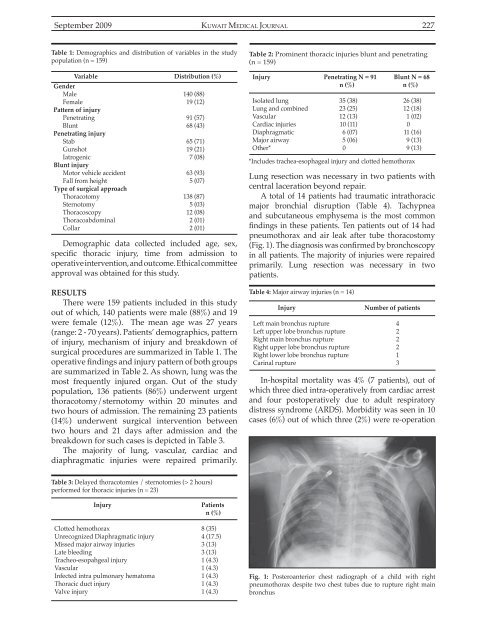Vol 41 # 3 September 2009 - Kma.org.kw
Vol 41 # 3 September 2009 - Kma.org.kw
Vol 41 # 3 September 2009 - Kma.org.kw
Create successful ePaper yourself
Turn your PDF publications into a flip-book with our unique Google optimized e-Paper software.
<strong>September</strong> <strong>2009</strong><br />
KUWAIT MEDICAL JOURNAL 227<br />
Table 1: Demographics and distribution of variables in the study<br />
population (n = 159)<br />
Variable Distribution (%)<br />
Gender<br />
Male 140 (88)<br />
Female 19 (12)<br />
Pattern of injury<br />
Penetrating 91 (57)<br />
Blunt 68 (43)<br />
Penetrating injury<br />
Stab 65 (71)<br />
Gunshot 19 (21)<br />
Iatrogenic 7 (08)<br />
Blunt injury<br />
Motor vehicle accident 63 (93)<br />
Fall from height 5 (07)<br />
Type of surgical approach<br />
Thoracotomy 138 (87)<br />
Sternotomy 5 (03)<br />
Thoracoscopy 12 (08)<br />
Thoracoabdominal 2 (01)<br />
Collar 2 (01)<br />
Demographic data collected included age, sex,<br />
specific thoracic injury, time from admission to<br />
operative intervention, and outcome. Ethical committee<br />
approval was obtained for this study.<br />
RESULTS<br />
There were 159 patients included in this study<br />
out of which, 140 patients were male (88%) and 19<br />
were female (12%). The mean age was 27 years<br />
(range: 2 - 70 years). Patients’ demographics, pattern<br />
of injury, mechanism of injury and breakdown of<br />
surgical procedures are summarized in Table 1. The<br />
operative findings and injury pattern of both groups<br />
are summarized in Table 2. As shown, lung was the<br />
most frequently injured <strong>org</strong>an. Out of the study<br />
population, 136 patients (86%) underwent urgent<br />
thoracotomy/sternotomy within 20 minutes and<br />
two hours of admission. The remaining 23 patients<br />
(14%) underwent surgical intervention between<br />
two hours and 21 days after admission and the<br />
breakdown for such cases is depicted in Table 3.<br />
The majority of lung, vascular, cardiac and<br />
diaphragmatic injuries were repaired primarily.<br />
Table 2: Prominent thoracic injuries blunt and penetrating<br />
(n = 159)<br />
Injury Penetrating N = 91 Blunt N = 68<br />
n (%) n (%)<br />
Isolated lung 35 (38) 26 (38)<br />
Lung and combined 23 (25) 12 (18)<br />
Vascular 12 (13) 1 (02)<br />
Cardiac injuries 10 (11) 0<br />
Diaphragmatic 6 (07) 11 (16)<br />
Major airway 5 (06) 9 (13)<br />
Other* 0 9 (13)<br />
*Includes trachea-esophageal injury and clotted hemothorax<br />
Lung resection was necessary in two patients with<br />
central laceration beyond repair.<br />
A total of 14 patients had traumatic intrathoracic<br />
major bronchial disruption (Table 4). Tachypnea<br />
and subcutaneous emphysema is the most common<br />
findings in these patients. Ten patients out of 14 had<br />
pneumothorax and air leak after tube thoracostomy<br />
(Fig. 1). The diagnosis was confirmed by bronchoscopy<br />
in all patients. The majority of injuries were repaired<br />
primarily. Lung resection was necessary in two<br />
patients.<br />
Table 4: Major airway injuries (n = 14)<br />
Injury<br />
Number of patients<br />
Left main bronchus rupture 4<br />
Left upper lobe bronchus rupture 2<br />
Right main bronchus rupture 2<br />
Right upper lobe bronchus rupture 2<br />
Right lower lobe bronchus rupture 1<br />
Carinal rupture 3<br />
In-hospital mortality was 4% (7 patients), out of<br />
which three died intra-operatively from cardiac arrest<br />
and four postoperatively due to adult respiratory<br />
distress syndrome (ARDS). Morbidity was seen in 10<br />
cases (6%) out of which three (2%) were re-operation<br />
Table 3: Delayed thoracotomies / sternotomies (> 2 hours)<br />
performed for thoracic injuries (n = 23)<br />
Injury<br />
Patients<br />
n (%)<br />
Clotted hemothorax 8 (35)<br />
Unrecognized Diaphragmatic injury 4 (17.5)<br />
Missed major airway injuries 3 (13)<br />
Late bleeding 3 (13)<br />
Tracheo-esopahgeal injury 1 (4.3)<br />
Vascular 1 (4.3)<br />
Infected intra pulmonary hematoma 1 (4.3)<br />
Thoracic duct injury 1 (4.3)<br />
Valve injury 1 (4.3)<br />
Fig. 1: Posteroanterior chest radiograph of a child with right<br />
pneumothorax despite two chest tubes due to rupture right main<br />
bronchus
















